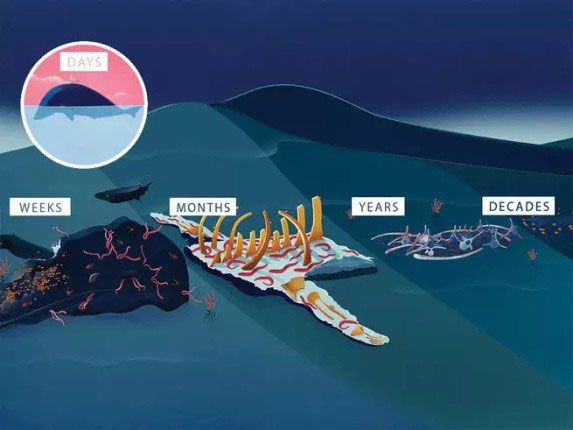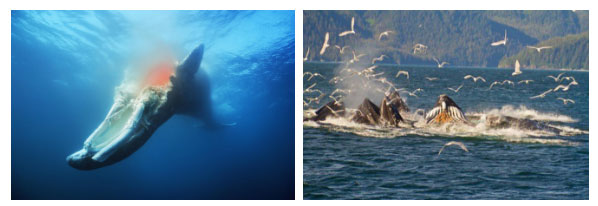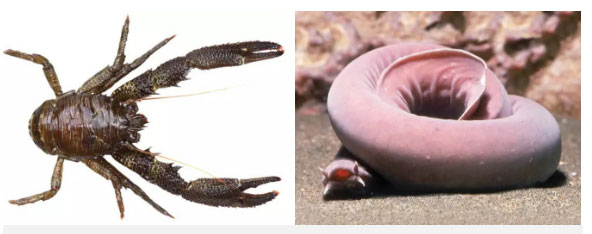Why are whales still useful until they die?
With a huge size, if the whale carcasses if washed ashore, it will always catch the attention of many people. But do you know - what happens when a whale dies and sinks to the sea?
It is estimated that every 70 thousand whales die each year. But then, their meat, fat and bone are the source of life for many other organisms. It can be said that the body of each whale is a miniature ecosystem in the deep sea.

The following will happen with whale carcasses.
Oceanographers have been investigating this problem since 1987. So far, they have known quite specifically the following things that will happen to whale carcasses.
A few days later: the fish body swelled up and sank
In the first phase of rotting, whale carcasses are often bulging and floating.

In the first stage, whale carcasses are often bulging and floating.
But then, carbon dioxide, methane and other gases in the body will dissipate. This change makes the whales sink into the water to hundreds, even thousands of meters.
Few weeks: meat feast of sharks, shrimps, .
The first "guests" to eat whale carcasses are crustaceans like squat crabs (squat crabs) , some sharp-toothed sharks and this deformed rocky salmon.

Lobster, squatting and grouper.
The hagfish (hagfish) looks like an eel but is a species of fish, 30 - 90cm long. They have skulls but have no spine, specializing in scavengers.
They can be eaten for months, with a "menu" that is very rich like organs, skin, and muscles. It is worth mentioning that when they are full, they still "save" a significant source of nutrition for later species.
A few months later: the viscous party of worms, snails .
At this time, whale carcasses have very little meat. But it will be covered by a plentiful layer of viscous microorganisms. This is also the source of food for snails or burning worms.

Multiple silk worms.
For example, they have bristle worms , they have survived five great extinctions thanks to the search for food on animal carcasses.
A few years later: the microorganism's bone party
When whale carcasses remain in the skeleton, it is still a food source for microorganisms. And there are some special microorganisms that science only finds on whale carcasses.
So, science sometimes "sinks" the bodies of whales washed up on the sea to the bottom, so that microbes can be collected later on.

Zombie worms find food from whale bones.
In addition, the zombie worm (osedax roseu) - a mollusk - also specializes in eating lipids from whale bones.
Dozens of years later: living resources for clams, oysters, snails, mussels .
The great whale carcass is true, but it has turned into thousands of small particles over the past decade. But, these are nutritious particles for bacteria on the seabed.

This bacterium specializes in clinging to the shells of boys and oysters .
These bacteria are specialized on the shells of boys, oysters . They help to transfer sulfide on the skin of the sugar, providing a living source for the mollusks inside.
Therefore, indirectly, whale carcasses feed clam, oyster, mussel, mussel . in the seabed after decades!
- The 'whale' is about the size of a dinosaur
- Whales cry because of aground, the action of the people makes everyone admire
- The death of old whales brings countless benefits to oceans and ecosystems
- Nearly 150 whales die on the coast of Australia
- Video: Flock of ferocious whales eating main meat
- Why are humpback whales disappearing in Hawaii?
- Whales love to take pictures of fun with divers
- 39 whales die from stranding
- Flock of hundreds of whales makes the scientific community confused
- Video: Whales familiarize people on the beach
- Canada: Race to save whales stuck in ice
- Video: Watching the whale 'killer' chasing a strange ship
 Surprised: Fish that live in the dark ocean still see colors
Surprised: Fish that live in the dark ocean still see colors Japan suddenly caught the creature that caused the earthquake in the legend
Japan suddenly caught the creature that caused the earthquake in the legend A series of gray whale carcasses washed ashore on California's coast
A series of gray whale carcasses washed ashore on California's coast Compare the size of shark species in the world
Compare the size of shark species in the world